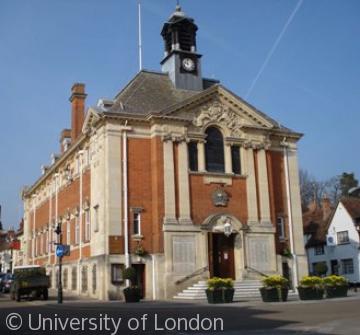Town Hall and Guild Hall

Henley's present town hall, completed in 1901, has had at least three predecessors, only one of which occupied the same site. There may well have been a town or guild hall as early as the 13th century, when Henley's Merchant Guild - a body of leading traders who effectively ran the town - was first recorded. But the first mention of a guild hall in the town archives dates from the early 15th century, when it stood on the south side of Hart Street a little way east of the crossroads.
A new guild hall was built in 1487-92, this time just west of the crossroads in the Middle Row, a line of buildings which ran along the middle of the market place. The building seems to have been timber-framed, with a jettied upper storey providing a large first-floor council chamber. Seventeenth-century paintings show it surmounted by a large lantern or cupola, though that was presumably a later addition. Some medieval guild halls had an open area below for market trading, though in the 18th century the ground floor here was occupied by a hall and kitchen. Possibly that was always the case, and an 18th-century ground-floor gaol a little further along the row may also reflect medieval arrangements. Certainly the hall must have been solidly built, since it continued to serve the town authorities until the Middle Row's demolition in the 1790s.
By then Henley had it grand new five-arched bridge, and was being transformed through the clearance of medieval clutter and the broadening and beautifying of its main streets and waterfront. After some controversy it was decided to build a new town hall on the site of a recently demolished market house further up the market place - the site of the present town hall. The new building was designed by the Henley builder William Bradshaw in a Palladian classical style, with a colonnaded front and a space underneath for market trading.
Plans for the present town hall go back to 1897, the year of Queen Victoria's Diamond Jubilee. Replacing Bradshaw's building was a highly controversial decision, but H.T. Hare, architect of the recently completed town hall in Oxford, was appointed in 1898, and the new town hall was completed three years later. The building is a visible expression of the town's municipal pride and confidence at the dawn of the Edwardian era, with its rich display of Baroque ornament and plasterwork. The red brick echoes the area's Georgian houses, though its grand pedimented front is unique in Henley. Parts of Bradshaw's demolished town hall were reassembled a few miles away at Crazies Hill, incorporated into a villa for the leading Henley builder Charles Clements.
Read more about Henley's town halls and guild halls. .
Content generated during research for the paperback book 'Henley-on-Thames: Town, Trade and River' (ISBN 13 : 978-1-86077-554-3) for the England's Past for Everyone series




